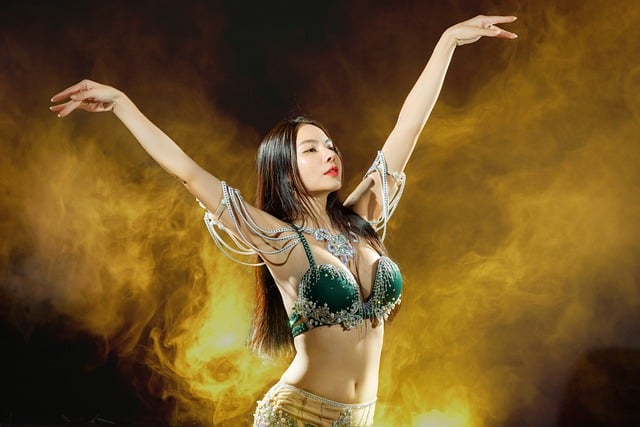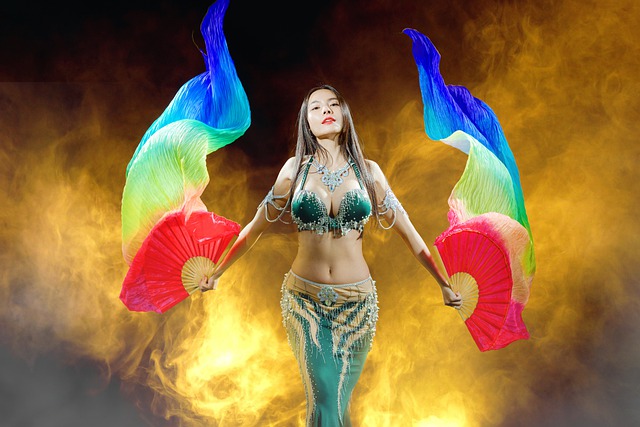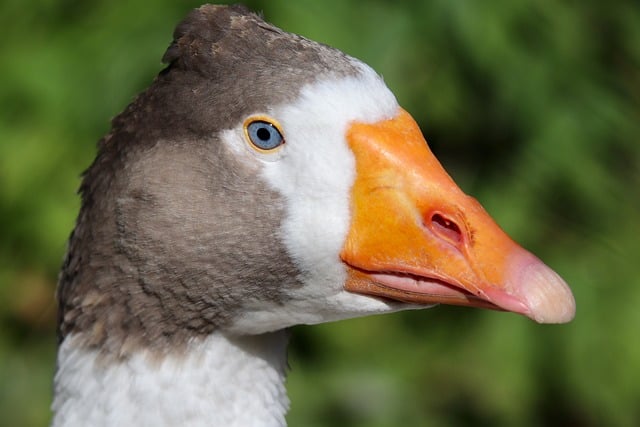In the realm of dance, a mesmerizing art form emerges from the depths of ancient cultures, captivating audiences with its grace and allure. Raqs Sharqi, also known as Oriental Dance or Belly Dance, is a vibrant and expressive style that has gained global recognition for its rich cultural heritage and intricate movements. Like a shimmering jewel beneath layers of history, Raqs Sharqi embodies a kaleidoscope of traditions that have shaped its essence.
This article delves into the origins and cultural significance of Raqs Sharqi, exploring its roots in the Middle East and North Africa. We will examine the techniques and movements that define this art form, unveiling the intricate footwork, isolations, and undulations that give it life. Additionally, we will uncover the unique characteristics that make Raqs Sharqi so captivating – from its fluidity to its ability to convey emotions through movement.
Join us on this journey as we unravel the mystique behind Raqs Sharqi – an ancient dance steeped in tradition yet ever-evolving. Discover how this enchanting art form transcends borders and connects people across cultures through its universal language of rhythm and expression.
Key Takeaways
- Raqs Sharqi is a vibrant and expressive style of dance that originated in the Middle East and North Africa.
- It combines fluid movements, intricate footwork, and graceful gestures, and has evolved from religious ceremonies to a form of entertainment.
- The dance is characterized by isolations of the hips, stomach rolls, undulations of the torso, and intricate hand movements.
- Raqs Sharqi celebrates diverse body types, empowers individuals through self-expression, and has influenced modern dance styles and body positivity movements.
Origins and Cultural Significance of Raqs Sharqi

Raqs Sharqi, also known as belly dance, has its origins in the Middle East and North Africa and holds significant cultural importance as a traditional form of expression that combines fluid movements, intricate footwork, and graceful gestures. This ancient art form has had a profound influence on modern dance styles across the globe.
The origins of raqs sharqi can be traced back to ancient Egypt and Mesopotamia, where it was performed by women during religious ceremonies and fertility rituals. Over time, it evolved into a form of entertainment enjoyed at social gatherings such as weddings and celebrations. The dance is characterized by isolations of the hips, stomach rolls, undulations of the torso, and intricate hand movements.
Music plays a vital role in raqs sharqi performances. Traditional Middle Eastern instruments like the oud (a stringed instrument), tabla (drums), and qanun (a plucked zither) accompany the dancers. The rhythm patterns in the music guide the dancers’ movements and add depth to their performances.
Raqs sharqi’s influence on modern dance can be seen in various genres such as contemporary fusion styles that incorporate elements of ballet or hip-hop with traditional belly dance techniques. Additionally, this art form has contributed to body positivity movements by celebrating diverse body types and empowering individuals through self-expression.
Raqs sharqi is an ancient art form with deep cultural significance that continues to captivate audiences worldwide. Its influence on modern dance is undeniable, showcasing its enduring relevance in today’s world of performing arts.
Techniques and Movements of Raqs Sharqi

One of the fundamental techniques in this traditional Middle Eastern dance is characterized by fluid and intricate movements that require great control and coordination. Raqs Sharqi, also known as belly dance, encompasses a variety of techniques and movements that contribute to its distinct style.
- Hip articulation: A defining feature of Raqs Sharqi is the emphasis on isolating and articulating movements of the hips. Dancers use various techniques such as hip lifts, drops, circles, shimmies, and figure eights to create dynamic and expressive movements.
- Veil work: Another notable aspect of Raqs Sharqi is the incorporation of veils into performances. The dancers skillfully manipulate large flowing veils to enhance their movements and create visually captivating effects. Veil work adds an element of gracefulness and elegance to the overall performance.
- Lyrical arm movements: Raqs Sharqi involves graceful arm movements that complement the fluidity of the hips. Dancers use sweeping motions, undulating waves, snake arms, and delicate hand gestures to create beautiful lines and add depth to their performances.
- Traveling steps: In addition to stationary hip and arm movements, Raqs Sharqi includes traveling steps that allow dancers to navigate across the stage or performance area while maintaining their technique. These steps may include gliding footwork patterns like grapevines or simple walking steps with added embellishments.
Overall, these techniques and movements combine to create a captivating display of artistry in Raqs Sharqi performances. The mastery of hip articulation, veil work, lyrical arm movements, and traveling steps allows dancers to express themselves through this ancient Middle Eastern dance form.
Unique Characteristics that Make Raqs Sharqi Captivating

The captivating nature of Raqs Sharqi lies in its ability to transport the audience into a world of mesmerizing movements and enchanting rhythms. This Middle Eastern dance form, also known as belly dance, is characterized by its unique characteristics that make it both visually stunning and emotionally evocative.
One key aspect that contributes to the captivating nature of Raqs Sharqi is the musicality and improvisation involved in its performances. Dancers are skilled at interpreting the music and expressing it through their movements with precision and grace. The rhythmic complexity of the music allows for intricate footwork, fluid isolations, and expressive gestures that captivate the audience’s attention.
Another factor that adds to the allure of Raqs Sharqi is the elaborate costumes and adornments worn by dancers during performances. These costumes are often ornate, featuring vibrant colors, intricate beadwork, and shimmering fabrics. The use of flowing veils, finger cymbals (zills), or prop accessories such as swords or fans further enhance the visual appeal of the dance.
To further illustrate these captivating elements, consider the following table:
| Musicality and Improvisation | Costume and Adornment |
|---|---|
| Interpretation of music | Elaborate costumes |
| Expressive movements | Vibrant colors |
| Intricate footwork | Ornate beadwork |
| Fluid isolations | Shimmering fabrics |
Raqs Sharqi’s ability to transport audiences through mesmerizing movements combined with enchanting rhythms stems from its emphasis on musicality and improvisation as well as its visually striking costumes and adornments. By incorporating these elements into their performances, dancers create an intimate connection with their viewers while showcasing the rich cultural heritage behind this captivating dance form.
Frequently Asked Questions
What are the health benefits of practicing Raqs Sharqi?
The practice of Raqs Sharqi, a form of Middle Eastern dance, offers numerous health benefits. It promotes mental well-being by reducing stress and improving self-confidence. Additionally, it enhances physical fitness through increased flexibility, coordination, and cardiovascular endurance.
Are there any specific costumes or attire required for performing Raqs Sharqi?
Different styles of raqs sharqi costumes include traditional Egyptian, modern fusion, and folkloric. Choosing the right music for a raqs sharqi performance involves considering the style, mood, and rhythm that complements the dancer’s movements.
How long does it typically take to become proficient in Raqs Sharqi?
Becoming proficient in raqs sharqi requires dedicated practice and learning of intricate techniques. The timeline varies depending on individual aptitude, commitment, and training frequency. With consistent effort, one can achieve proficiency in this captivating dance form, transcending cultural boundaries.
Are there any age limitations for learning or performing Raqs Sharqi?
Age restrictions for learning or performing Raqs Sharqi are not clearly defined. However, it is generally recommended that dancers start at a young age to develop the necessary flexibility, coordination, and cultural understanding required for this traditional Middle Eastern dance form.
Can men also practice and perform Raqs Sharqi, or is it exclusively for women?
Men can practice and perform Raqs Sharqi, a Middle Eastern dance style. While traditionally associated with women, men have also embraced this art form. It holds cultural significance for women, allowing them to express femininity and celebrate their bodies within societal boundaries.
